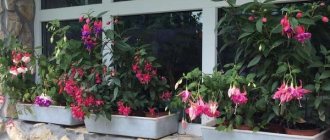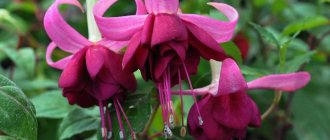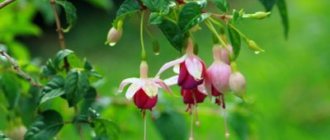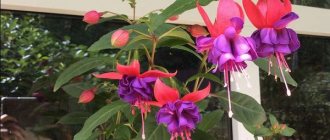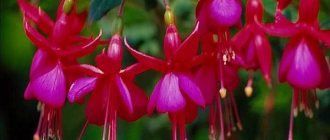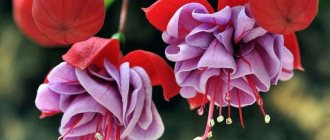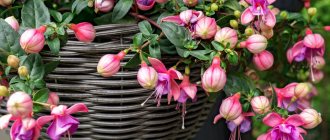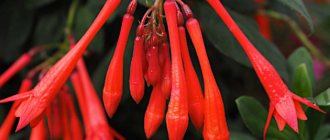In the Fuchsia genus of the Fireweed family (Onagraceae), there are 113 (1) evergreen and deciduous species. The genus is named after the famous German scientist Leonard Fuchs, a botanist and physician who first described it in his fundamental work “The History of Plants.”
In the natural flora, fuchsias are found in Central and South America, as well as in New Zealand. In culture today, along with individual species and their varieties, hybrid fuchsia (Fuchsia hybrida) is most often grown.
In nature, the life forms of fuchsias are shrubs, shrubs, subshrubs and even small trees with opposite or whorled oval or lanceolate leaves. The surface of the leaves is smooth (matte, glossy) or velvety.
Any fuchsia has a bright personality thanks to drooping flowers of various colors and original shapes. They are called ballerinas, gypsy earrings, Chinese lanterns, dolls, trinkets. Fuchsia flowers are an excellent subject for both spectacular photographs and thoughtful consideration. And the structure of the flower is very convenient for artificial pollination when creating new varieties. It consists of a tubular calyx that ends in four spreading sepals, a corolla with straight petals that form a crown, long stamens and a pistil (ballerina's foot), which hang a few centimeters below the petals.
Flowers are simple (non-double), semi-double, double. Semi-double fuchsias have up to 7 petals in a flower, while double fuchsias have 8 or more petals.
Fuchsias bloom from spring to late autumn, and under favorable conditions almost all year round.
The fruit is an edible berry. The seeds are very small, almost flat, light brown.
What is it: general description
Fuchsia is an ornamental plant from the fireweed family . These are small trees or shrubs with flexible shoots of a reddish color, medium-sized lacent or ovate leaves located opposite, and numerous flowers of various shapes and colors.
This ornamental crop has a bushy or creeping appearance. A distinctive feature of fuchsia is the flower. It consists of two parts - a corolla-shaped calyx and a bell-shaped or tubular corolla (skirt) of a different color. All parts of the flower are brightly colored.
Fuchsia varieties that have 4-5 petals and a rather small flower are called non-double . Large fuchsias, the corolla of which consists of many petals, are considered terry.
Attention : This culture belongs to the group of unpretentious plants. Fuchsia is easy to care for and grow and perfectly decorates the interior.
Origin: Brief History
Fuchsia is named after the famous German scientist, botanist and physician Leonard Fuchs .
This plant was discovered by Catholic priest Charles Plumier at the end of the 17th century. He traveled across the South American continent in search of medicinal plants and found this plant there. In 1703, in the book Nova Planetarium Americanum Genera, an article about the discovery of a new species was first published. According to the generally accepted version, this date became the “birthday” of fuchsia.
general information
Many people are interested in what a fuchsia flower looks like. The photos that you can see below will not leave anyone indifferent. This is a truly amazing plant with excellent decorative properties. The leaves have a regular oval shape and green color. The shoots are light, and the petioles are slightly red. In most species they are arranged in pairs.
To date, breeders have developed a huge number of indoor fuchsia varieties. Photos of flowers look simply amazing. Depending on the variety of crop, flower stalks can have different colors, ranging from snow-white to purple. The buds are formed by a uniquely shaped sepal, skirt and stamen. In some way they resemble bells.
Brief answers to frequently asked questions
What are the differences between indoor plants and other types?
In indoor culture, preference is given to hybrid fuchsias . In English they are also called “Hybrid Fuchsia - F. x. Hybrid." These types of plants have collected all the best qualities of the original varieties. Hybrid varieties are unpretentious, resilient and grow very quickly at home.
The most popular and beautiful types of indoor fuchsias are:
- Fuchsia is elegant.
- Fuchsia brilliant.
- Fuchsia Magellanica.
- Fuchsia hybrid.
Is it possible to eat the fruit?
Fuchsia fruits are quite edible . In cooking, they are used to prepare various delicacies: jam, confitures, sweet sauces, liqueurs and fillings for pies. When ripe, the berries are black-purple in color, and cooks often use them to decorate their dishes.
Important : If you are hypersensitive, fuchsia can be harmful to your health. If the flower was treated with pesticides, then eating the fruit is dangerous to health.
Garden species and those that can be kept at home, their photos
To decorate gardens and parks, varieties of large fuchsias that are prone to strong growth are used . They have straight shoots and reach half a meter. Such plants require careful care and long-term shaping. Flowers can be of a wide variety of colors.
Garden fuchsias are represented by the following varieties.
Australian
Australian ones are tall, with rich, bright, large flowers (Matilda, Walsing).
Exotic terry
Exotic double fuchsias - flowers of medium and small size . They have a large selection of shades (Sarah Jane and Florentina).
Sapphires and Diamonds
Sapphires and Diamonds are high-type fuchsias with large flowers, combining white with a variety of brightly saturated blue shades (Capri, Ultramarine and Dark Secret).
Winter-hardy
Winter-hardy fuchsias - survive well under snow, even without shelter (Garden News, Bacon, Konstanz).
Three-leaved
Three-leaved fuchsias have leaves with a red tint, reach half a meter , and the flowers are small, dark coral, collected in racemes. They are also considered a container type (Express and Orient).
Hybrid varieties
Hybrid varieties are very common among indoor fuchsias. There are more than 2000 types of hybrids. They can be divided into bush and hanging.
Ampelous
Ampelous fuchsias are grown in hanging baskets and flowerpots, as they have flexible creeping or drooping shoots . Cascade, Alice Ashton, Imperial Crown, Hollies Beauty are well-known varieties of this species.
Bush
Bush fuchsias are recommended to be fixed on special supports. They are grown in pots or containers. Anabel, Henriette Ernst, Alisson Bell, Armbrough Campbell - varieties of bush fuchsias.
Indoor varieties
Indoor varieties of fuchsias differ in the type of flowers , they are divided into:
- simple - Brutus, Winston Churchill;
- semi-double - Satellite, Tennessee Walts;
- terry - Midge, Fashion, Swingtime;
- racemes - Yellow, Swanley, Leverkusen.
Does it bloom in winter?
Fuchsia can bloom in September and even until the end of autumn in warm weather. In winter, this crop enters a dormant period. To ensure normal wintering, it is necessary to place the fuchsia in a cool place and limit watering. Storage in the basement is suitable for this.
Is it perennial?
Fuchsia is a perennial shrub . Tolerates wintering well at home. The decorative properties of some varieties do not appear in the first year. There are varieties that reveal their potential in the second year of life. Garden fuchsias that are afraid of frost are brought indoors for the winter, observing the appropriate temperature conditions (find out how to preserve fuchsia in winter here). Pruning is carried out in the second half of winter, after which new shoots should appear. In spring, the flower must be propagated by cuttings.
Combinations with other colors
Psychologists are sure that this color lifts the mood and makes girls positive and feminine. But sometimes it is perceived by men as an indicator of frivolity and defiant behavior. This is why it is so important to choose the right combination. The fact that you will arouse interest is unambiguous, what matters is what it will be.
Grey
This combination is considered classic and practical. Rich fuchsia and gray complement each other perfectly, creating a sophisticated look. You can complement the outfit with a gray coat.
Jewelry made of metal or wood, for example, beads or a bracelet, can be used as accessories for such an ensemble. It looks very gentle and energetic. The combination of gray and fuchsia in everyday looks also allows for the use of massive jewelry. They look appropriate and brighten up the look.
A blouse made of flowing fabric and classic gray trousers are the ideal choice for a girl with a slender figure. You can complement your outfit with eye-catching jewelry to give it some flair. Gray brings fuchsia down to earth perfectly, it no longer looks so flashy.
Black
Don't know what to wear with a bright fuchsia skirt? Choose expressive black! A blouse, boots, hat and bag in a dark shade will create the desired effect. The image turns out attractive and sexy, even despite the strict styles.
This beautiful ensemble with a biker jacket is quite attractive for young women. Neutral black creates a contrast that highlights the richness of the fuchsia.
A set consisting of black trousers will look very nice. The ensemble can be complemented with pumps with heels or flat soles, a fuchsia jacket, a black top, and a bag. This tandem looks very stylish and fashionable. If you decide to wear a blouse not with trousers, but with a skirt, then opt for a model with a straight silhouette and a high waist. Jeans are in fashion today, so they can also be included in your outfit.
Light blue and blue
The combination of fuchsia and blue allows you to create a bright and dynamic look for a summer walk. The image turns out to be positive and life-affirming. This combination will highlight a beautiful tan and add freshness.
A bright, but not intrusive image is also obtained with shades of blue. We consider blue and cyan in the same block because they create identical combinations with fuchsia. These outfits are distinguished by restraint, earthiness and tenderness. If you want to create a more businesslike, but casual look, you can wear a jacket made of expensive fuchsia fabric, as well as a dress with blue stripes in a nautical style.
Red
Expressive shades with inner strength create an excellent shocking duet. The red color in the outfit should occupy a secondary or equal position, otherwise the image will turn out to be too bright and, perhaps, even tasteless. The set below will be paired with high heels. Keep the look simple with other shoe options.
Deep red and fuchsia with a hint of sass are ideal for young, bold girls.
If served correctly, this combination will not be vulgar. On the contrary, it will give you tenderness.
Beige and brown
Combinations with beige in some cases can even be used for office style. It fascinates and helps a woman feel her fragility, and also makes any outfit romantic and delicate.
Brown is a deeper color, so images with it are rich and saturated.
Fuchsia blooms in this combination, and brown acts as the main shade.
Green
The combination looks rich if you get the right shades correctly. Colors should not hurt the eyes. Choose calm and noble tones of fuchsia and green. They will refresh you and give you confidence. The combination is suitable for everyday wear and special occasions. Sometimes with these shades it is possible to create images for work.
In this combination, it is important to ensure that the colors cooperate with each other, and do not interrupt with brightness. Similar looks are popular in the fashion world and have almost become a trend.
A natural, summer combination gives a good mood and freshness. In some shades of green and fuchsia, images look not only beautiful, but also expensive.
White
White is a classic color that will never go out of style. Therefore, the combination of fuchsia and white is an option you can rely on. The photos show the outfits, as you can see, they can be completely different.
In a white dress you will look like a doll, and in combination with accessories you can make your look more elegant. Outfits with white are suitable for those who want brightness in everyday life.
A fuchsia suit and a white T-shirt are appropriate, for example, if you are going to work, where there is no dress code, or for a walk in the park. With such colors in your outfit it is impossible to be invisible, keep this in mind. The combination is striking at first glance, but many employers completely allow this form of clothing in their companies.
Orange
A popular combination in recent seasons. The shades complement each other perfectly. In clothes they should be combined with caution, maintaining balance, but accessories can be selected in both colors without restrictions.
Stylists recommend always adding a third color to a fuchsia-orange look, for example, yellow.
You can combine bright fuchsia dresses with an orange jacket, it looks beautiful and noble.
Yellow
The combination of yellow and fuchsia looks sunny in summer. The outfits look impressive, irresistible and playful. What additional colors you will combine yellow and fuchsia with is up to you. The ensemble allows for almost all shades.
A charge of energy and sunny mood - this is how you can describe the combination of yellow and fuchsia. Ladies love to create such sets because the shades represent cheerfulness, happiness and romance.
Total fuchsia
We recommend choosing a look in one color for special occasions. In everyday life, single-color outfits may look too bright. Many designers this season presented total fuchsia looks.
By combining bright shades, you can create amazing looks in one color. They almost always turn out to be passionate and unusually attractive.
How to grow at home?
You can grow fuchsia at home from seeds. They are placed immediately in a container with specially prepared soil or in a peat tablet. Shoots appear in 20-30 days. After a pair of true leaves appear, the seedlings are transplanted into separate pots. During the period of growing up, it is necessary to regularly remove the top, that is, pinching. This will help form the bush. This fuchsia should bloom in the second year.
Tip : The soil for growing fuchsias from seeds should be slightly moist, but not wet.
Fuchsia propagation rules
There are two methods for obtaining new fuchsias: seed and cuttings.
Seeds
This is a rather labor-intensive process, which, as a rule, does not preserve the individuality of the mother flower. Seeds are sown in early spring:
- Since they are very small, they are mixed with sand and scattered on the surface of the soil.
- Sprinkle with a small amount of substrate.
- Cover with film or glass.
- Maintain temperature +15…+18 °C. Water into a tray.
- Sprouts appear within a month.
- When two sheets are formed, they are picked.
Vegetative
Old or young shoots (about 10 cm) are used as cuttings, which are cut at the end of winter:
- The lower leaves are removed. The cuttings are placed in a glass with water, liquid substrate or sand.
- Create a mini-greenhouse using a plastic container or bag.
- After 2 weeks, when roots appear, the cuttings are replanted.
When can I transplant it outside?
When the rhizome develops and grows throughout the pot, the fuchsia is planted outdoors . By that time, the flower should have several shoots with leaves. Fuchsias love morning sun, so it is best to plant them on the east side. Although there are varieties that need shade in the afternoon.
Fuchsia is planted in a hole half filled with compost. It is good to do this by transshipment, that is, the plant is taken from the pot along with the soil. The walls of the hole are also filled with compost. Find out how to grow fuchsia, including in the garden, here.
Red
Red and fuchsia are two colors that harmonize wonderfully with each other. They are located next to each other on the color wheel and form a monochrome harmony. Scarlet, carmine, marsala, coral, burgundy - a combination with any of these colors will be ideal.
How to properly care for it and make it produce buds?
- Light . Fuchsias develop well in artificial and natural light. But there must be enough light. Otherwise, the plant will stretch out and will not bloom.
- Temperature . In summer, the optimal temperature for fuchsia is 18-20 degrees. In hot weather, it is better to take the flower outside. In winter, the temperature drops to 8-10 degrees.
- Watering . Regular, abundant but moderate watering should be provided. In winter it is significantly reduced. Spraying and washing are done periodically. Water for irrigation must be settled.
- Fertilizer . For full growth and flowering, you need to fertilize the flower once every two weeks with special fertilizers for flowering plants. Such options as “Peters”, “Kemiru” are suitable. In winter there is no need for fertilizing.
- Trimming . Pruning or pinching is a prerequisite for proper care of these flowers. Pinching begins at the cutting stage and lasts throughout the life of the fuchsia. It is preferable to do this procedure in the spring, before the flowering period. To form a bush, you need to pinch the side shoots after 3 or 4 pairs of leaves.
- Reproduction . It is recommended to combine propagation with pruning. Cuttings are rooted in water or directly in the ground. Rooting time ranges from several days to a month, and depends on various factors. It is advisable to periodically spray shoots that take root. Learn more about fuchsia propagation. including about growing from a leaf, we talked here.
Read more about the basic rules for caring for fuchsia at home here.
Methods for pruning fuchsia
Fuchsia is pinched to stimulate good flowering, the appearance of a large number of young shoots, as well as to form the plant into a ball, bush, or bonsai tree.
It is pruned twice a year: after flowering in October and during the dormant period in January.
Autumn
Remove stems that have bloomed. Dormant buds are left 2 cm below the cut.
Winter
Thin shoots are removed, woody old ones are pruned, since flowers are formed mainly on young shoots.
Bonsai
When forming a small tree, one shoot or several are left that can be twisted. The top is pinched to create a lush crown.
Bush
If you shorten the flower to the very stump, it will remain dormant longer, bloom late, but at the same time it will produce many young shoots and the plant will take on the appearance of an extensive shrub.
How to replant?
The annual replanting of fuchsia is carried out in the spring. First, a drainage layer is created (expanded clay can be used). A little soil mixture (leaf soil, humus, peat) is poured onto the drainage. Carefully transfer the flower with a lump of earth to the prepared place. The remaining earthen mixture fills the voids in the pot.
The transplanted plant is placed indoors or on a window with sufficient light, watered well, sprayed and the shoots are cut by a third.
We recommend watching a video about replanting and pruning fuchsia:
Transfer
Fuchsia flowers grow very quickly, so it is necessary to transplant the crop into a new pot. The diameter of the container should be 3-4 cm larger. Experienced flower growers advise doing this in the spring, when fuchsia comes out of dormancy. It is best to purchase a ceramic pot. It will be able to protect the root system from overheating on hot days.
As when planting a plant in the ground for the first time, it is necessary to put a 2-3 cm layer of drainage on the bottom. Then add a soil mixture intended for flowering indoor plants. It can be purchased at a special gardening store.
However, you can prepare the soil yourself. To do this, you will need turf and leaf soil, peat, humus and coarse river sand. The transshipment method is suitable for transplantation. It consists of placing fuchsia on a small layer of soil along with a lump of substrate from an old pot, and filling the voids with a new soil mixture.
Upon completion of the transplantation, it is necessary to place the fuchsia on a shelf with diffused lighting, cutting its stems to a third of the length. The leaf blades need to be sprayed and the soil watered with settled water. Excess liquid will drain into the pan, from where it should be poured out after a few minutes. There is no need to add fertilizer to the soil for 4 weeks after transplanting. In just 2 months, fuchsia will begin to bloom abundantly.
Why doesn't it bloom?
Flowering is usually profuse with proper care. There are a number of factors influencing the lack of flowering of fuchsia :
- not enough light;
- temperature too high;
- incorrect amount of fertilizer;
- pruning done late;
- poor conditions for wintering the plant;
- a pot of inappropriate volume (until the root system covers the entire pot, the fuchsia will not bloom).
We recommend looking at why fuchsia does not bloom:
Watering mode
This is one of the most important aspects regarding the cultivation and maintenance of indoor and garden fuchsias (photos of flowers confirm the highly decorative nature of the culture). The frequency of watering is influenced by many factors, among which the most important are the following:
- variety;
- age;
- growth stage;
- location of flowers;
- soil type;
- pot size;
- climatic conditions.
Without feeding, fuchsias can grow normally for a very long time, but without water they will simply die. Therefore, maintaining the watering regime is very important. The soil should absorb moisture well and not stagnate at the root system. As soon as the top layer of the substrate becomes dry, this indicates the need for another watering. Any water that accumulates in the tray must be poured out. Excess moisture can lead to rotting of the rhizome and death of the plant.
Fuchsia flowers (photos of plants will pleasantly surprise even experienced gardeners with their beauty) experience a special need for moisture during the active growing season. In summer, they should be watered every three days. If you live in a region with a hot climate and little precipitation, the intensity increases.
At the beginning of autumn, the abundance of watering is gradually reduced, as the plant begins to prepare for dormancy and hibernation, so it no longer requires copious amounts of moisture.
Signs and superstitions
Every plant has some kind of superstition associated with it. Is it good or bad for this plant to be at home? As for fuchsia, many positive qualities are attributed to it.
When this plant is in a house or apartment, it:
- helps develop intuition and creative skills;
- harmonizes the energy in the room;
- supports health in those who suffer from diseases of the thyroid gland and digestive system;
- promotes mutual understanding between children and parents;
- drives away apathy and helps find a way out in a difficult situation;
- adds cheerfulness;
- makes its owner irresistible and charming.
There is also a superstition that fuchsia is a widow's flower . But, despite this, the flower is so luxurious and charming that almost none of the female flower growers attach importance to this strange statement.
Black
Black + fuchsia is one of the most winning color combinations. This duo is full of charm. Elegant, daring, elegant - it will be appropriate in any situation.
Diseases and pests
With proper care, strong immunity protects fuchsia from diseases and resists pests. However, there are a number of diseases that can affect your plant.
Powdery mildew is characterized by a pronounced white coating and the appearance of liquid droplets.- Gray rot makes the plant watery and soft. A plaque appears on the leaves. The cause is too humid air.
- Rust appears as brown spots, spreads very quickly and requires immediate treatment. If you keep the flower in the required microclimate, you can avoid the use of drugs and preserve the plant.
Fuchsia can also be affected by pests such as whiteflies, spider mites and aphids. To cure the plant it is necessary to use insecticides.
Selecting a location
It is best to place fuchsias (pictures of flowers can decorate any interior) on the windowsills of windows that face the east or north side of the house. However, even here they need protection from direct sunlight. Blinds or curtains will help provide this. In winter, plants will experience a lack of light, so artificial lighting is a prerequisite for growing fuchsias. For normal growth and development of this crop, the daylight hours should be twelve hours.
In summer, plants suffer greatly from the heat, so it is best to place them on a balcony or take them out into the open sky and leave them under the canopy of trees, where the sun's rays will hit the flowers only in the morning. During the hottest period of the day, fuchsias feel comfortable in partial shade. During the active growing season, it is not recommended to change your location. Frequent moves are stressful for the plant, which can cause it to drop all its buds and stop blooming.


